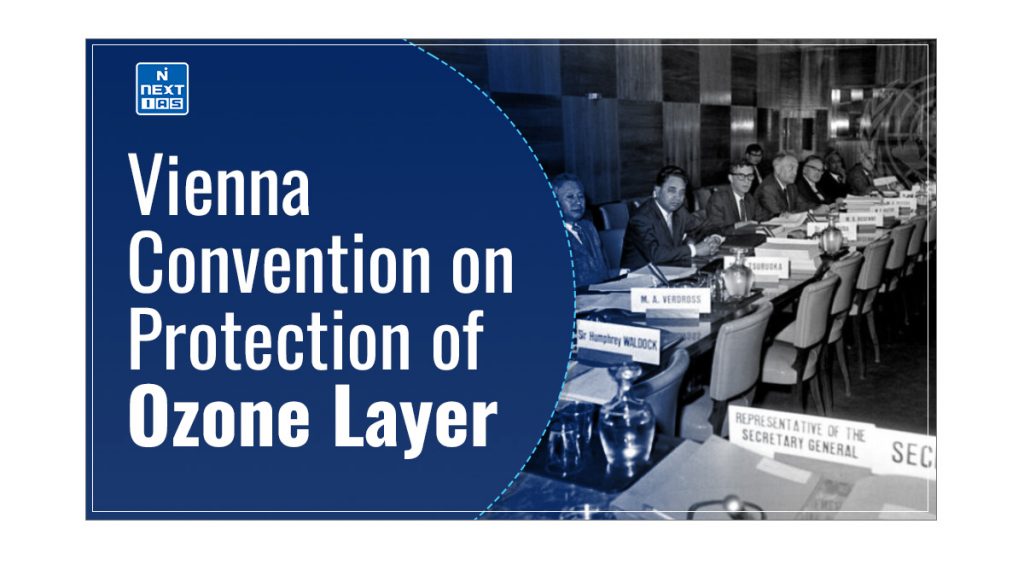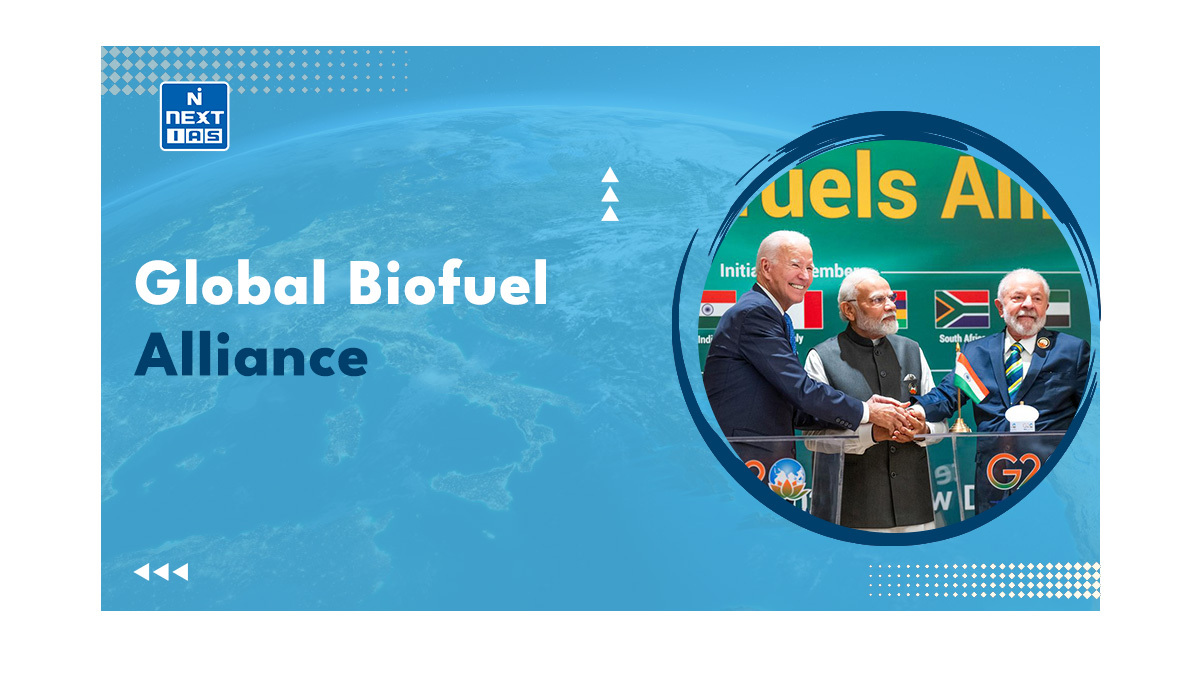
The Vienna Convention for the Protection of the Ozone Layer, adopted in 1985, is a critical framework for international cooperation to combat ozone depletion. Its significance lies in fostering global action to reduce harmful substances, thereby protecting the ozone layer and promoting public health. This article aims to study in detail the history, objectives, key provisions, and impact of the Vienna Convention.
About Vienna Convention
- The ozone layer is a region of the Earth’s stratosphere that contains a high concentration of ozone (O₃). It plays a crucial role in protecting life on Earth by absorbing most of the sun’s harmful ultraviolet (UV) radiation.
- The Vienna Convention for the Protection of the Ozone Layer was established as a global framework to combat ozone depletion, initiated in response to growing scientific evidence and public concern about the dangers of ozone layer depletion.
History of Vienna Convention
- The ozone layer in the Earth’s stratosphere plays a vital role in shielding the planet from harmful ultraviolet (UV) radiation.
- Its depletion, primarily caused by human-made chemicals like chlorofluorocarbons (CFCs), became a significant environmental concern in the late 20th century.
- Scientific studies revealed alarming evidence of ozone depletion, particularly the thinning of the ozone layer over Antarctica, commonly referred to as the “ozone hole.”
- Researchers began linking CFCs and other ozone-depleting substances to the deterioration of the ozone layer.
- Mario Molina and F. Sherwood Rowland’s 1974 publication highlighted the destructive impact of CFCs on ozone, prompting increased scientific scrutiny.
- The first significant international response occurred in 1985 at a meeting in Helsinki, where scientists, policy-makers, and environmentalists convened to discuss the threat of ozone depletion.
- Growing public awareness and concern about UV radiation’s harmful effects on human health and the environment led to pressure for action.
- In response to the mounting evidence and international pressure, the Vienna Convention for the Protection of the Ozone Layer was adopted on March 22, 1985. It aimed to provide a framework for global co
- operation in protecting the ozone layer.
Objectives of the Vienna Convention for the Protection of the Ozone Layer
The Vienna Convention, adopted in 1985, outlines several key objectives aimed at safeguarding the ozone layer:
- To encourage collaboration among countries through systematic observations, research, and information exchange regarding the effects of human activities on the ozone layer.
- Supporting and facilitating scientific studies to improve understanding of ozone depletion and its consequences enables informed decision-making and policy formulation.
- To encourage countries to adopt necessary legislative or administrative measures to combat activities that may adversely affect the ozone layer.
- To provide a structured framework for countries to address ozone depletion collectively, leading to the adoption of subsequent agreements, including the Montreal Protocol.
- To promote the sharing of knowledge and best practices among nations to effectively manage and protect the ozone layer.
- To increase awareness about the importance of the ozone layer and the impacts of its depletion, encouraging public and governmental support for protective measures.
Key Provisions of Vienna Convention
The Vienna Convention for the Protection of the Ozone Layer includes several key provisions to foster international cooperation and effective governance in ozone protection.
- Article 1 clearly defines essential terms related to the ozone layer and depleting substances, ensuring a common understanding among signatory countries.
- Article 2 outlines the Convention’s primary objectives, emphasising the commitment to protect the ozone layer while promoting collaboration.
- Article 3 encourages systematic observations and information exchange about the effects of human activities on the ozone layer.
- Article 4 establishes the obligation for parties to adopt preventive measures against activities likely to harm the ozone layer.
- Article 5 underscores the importance of scientific research and monitoring to inform policy decisions.
- Article 6 mandates exchanging relevant data among parties, facilitating transparency and accountability.
- Article 7 requires periodic reporting on actions to protect the ozone layer, ensuring compliance.
- Article 8 provides for financial mechanisms to support developing countries in their efforts to address ozone depletion.
- Article 9 establishes regular meetings of the parties to discuss progress and make decisions.
- Article 10 allows for amendments to the Convention, ensuring it can adapt to new scientific findings and changing circumstances. These provisions create a comprehensive framework for global action to protect the ozone layer.
Implementation Mechanisms of Vienna Convention
The Vienna Convention for the Protection of the Ozone Layer includes several key mechanisms to ensure effective implementation:
- The Convention establishes a systematic framework for monitoring and reporting compliance among its parties.
- Countries must periodically submit reports detailing their actions to protect the ozone layer, including measures taken to reduce or eliminate ozone-depleting substances (ODS).
- This process fosters transparency and accountability, enabling the global community to assess progress.
- UNEP plays a crucial role in supporting the implementation of the Convention.
- It provides scientific and technical expertise, facilitates information sharing among countries, and organises parties’ meetings to discuss progress and challenges.
- UNEP also aids in developing guidelines and best practices for ozone layer protection.
- Various capacity-building initiatives are directed toward developing countries to support the effective implementation of the Convention.
- These initiatives include training programs, technical assistance, and funding to help these nations enhance their capabilities in monitoring, reporting, and managing ozone-depleting substances.
Impact of Vienna Convention
The Vienna Convention has had a significant positive impact on both the environment and public health:
- The Convention and its companion agreement, the Montreal Protocol, have led to substantial reductions in the production and consumption of ozone-depleting substances.
- Many countries have successfully phased out or significantly reduced their use of CFCs and other harmful chemicals, contributing to the ozone layer’s recovery.
- The reduction of ODS has resulted in numerous environmental and health benefits.
- By decreasing the amount of UV radiation reaching the Earth’s surface, the Convention has contributed to a decline in skin cancers, cataracts, and other UV-related health issues.
- Additionally, the ozone layer recovery supports biodiversity and protects ecosystems sensitive to UV exposure.
- The long-term effects of the Convention are promising. Projections indicate that the ozone layer is on track to recover to its pre-1980 levels by the middle of the 21st century.
- This recovery will benefit human health and play a crucial role in climate change mitigation.
- Many ozone-depleting substances are also potent greenhouse gases; thus, their reduction contributes to global efforts to limit climate change.
- The Convention exemplifies a successful multi-faceted approach to environmental governance by addressing both ozone depletion and climate change.
Conclusion
The Vienna Convention has significantly reduced ozone-depleting substances and enhanced global collaboration on environmental protection. Its successful implementation contributes to the recovery of the ozone layer and aids in climate change mitigation. This Convention is a powerful example of how coordinated action can lead to positive environmental outcomes, highlighting the importance of ongoing commitment to safeguarding our planet.
Frequently Asked Questions (FAQs)
What is Vienna Convention?
The Vienna Convention is an international treaty that provides a framework for protecting the ozone layer.
What do Montreal Protocol and Vienna Convention deal with?
The Montreal Protocol and Vienna Convention explicitly address substances that deplete the ozone layer by phasing out the production and consumption of ozone-depleting substances.





